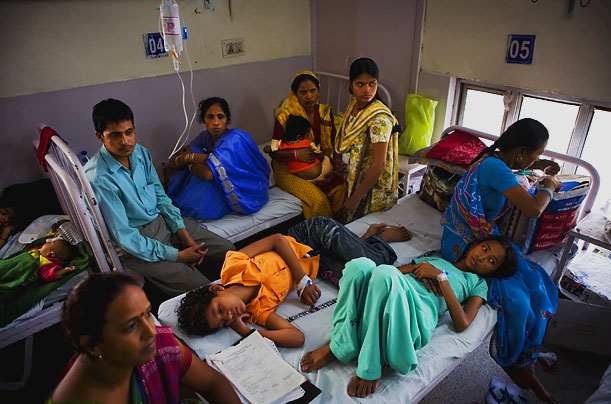Improving affordability and access to healthcare for the poor requires innovative design and cooperative community-based solutions, writes MOIN QAZI.
——–
INDIA’S healthcare remains an Achilles’ heel and continues to undermine economic progress. This is largely on account of the abysmal and chaotic healthcare system.
India ranks close to the bottom in international rankings in most health indices and performs poorly on multiple dimensions. India ranks 145th among 195 countries listed on the Healthcare Access and Quality Index (HAQ). India’s healthcare spending is at 3.5 percent of Gross Domestic Product (GDP), which is significantly lower than its peers such as China (5 percent), Vietnam (5.5 percent), South Africa (8.1 percent), and Japan (10.9 percent).
At least two-thirds of India’s 1.4 billion people depend on the public healthcare system, but the country has only 8.5 hospital beds and 8 physicians per 10,000 people. Compare this with Japan and South Korea, which have 120 and 130 beds per 10,000 people respectively.
While India has taken initiatives to improve access to healthcare through various public health schemes, the quality of care remains low due to poor infrastructure, unskilled staff, and limited coordination among Healthcare Service Providers (HSPs). For example, only 11 percent of sub-centers and 13 percent of Primary Health Centres meet the norms set by the Indian Public Health Standards (IPHS).
Also Read: Urgent Measures Needed to Rescue the Indian Health System; Health Status is Shocking
COVID-19 has laid bare the realities of the weak health infrastructure in the country.
But beyond the crisis unleashed by the pandemic, it is the critical solutions that were developed in its aftermath which can help reframe the future of health care, for the better, in our country.
Developmental Benefits of Good Healthcare
A sound health system enables countries to make the most of their strongest asset: human capital.
Physical and mental wellbeing is at the core of creating communities that thrive. Poor access to healthcare is the main impediment to poverty reduction and drives inequality. Health is a foundational investment in human capital and in economic growth.
The government’s development wisdom is now focused on identifying the strategic leverage points, where successful actions will trigger many supportive reactions.
That health is a clear priority for present and future generations underpin the objective of achieving universal health coverage. It is a critical leverage point where government action can have maximum impact.
The government’s development wisdom is now focused on identifying the strategic leverage points, where successful actions will trigger many supportive reactions.
The government needs to supplement curative services with preventive measures.
It must strengthen ancillary civic services like insect management, water purification systems, sewage systems and plants for treatment of industrial effluents and waste.
Poor hygiene and sanitation lead to pneumonia, malnutrition, malaria and tuberculosis across the country.
India must revitalise the public health system to ensure access, outcome, quality and affordability.


Making Healthcare Affordable
Poor families have long suffered the triple curse of sudden illness- the trauma associated with sickness, the financial burden of intensive healthcare and the loss of wages.
Historically, out-of-pocket expenditure has been a major source of financing healthcare in India. It still contributes to 70 per cent of all healthcare spending. It is no surprise then that 3-7 percent of the country’s population is pushed into poverty every year merely due to unexpected healthcare outlays. This results in less money for food, education, housing and long-term plans.
Community-based health insurance, rather than market mediated or government-provided insurance, is widely considered an appropriate way of reaching and protecting the poor.
A health event is a bigger risk to farmers than an unsuccessful crop. Once they sell their land or livestock, they become indentured labourers and that takes a generation or more to fix.
Health insurance is emerging as an important financing tool in meeting the healthcare needs of the poor. In fact, the poor prefer health insurance to life insurance. As they say, “We die once but go to the doctor many times each year.”
Also Read: Covid-19 Impact: Huge Decline in People Accessing Health Services
By managing risks and avoiding debt, those who have micro-insurance policies are in a position to protect the meagre wealth they accumulate. This helps them generate more income and even get a fair chance to rescue themselves and their families out of the mire of poverty. Community-based health insurance, rather than market mediated or government-provided insurance, is widely considered an appropriate way of reaching and protecting the poor.
The development of private health insurance has potential risks and benefits in terms of healthcare access for the poor. While it can result in substantial long-term welfare benefits, it is also unaffordable for most low-income families.
Inaccessibility and Inefficiency of a Well Designed Healthcare System
The biggest disease burden sits on the bottom pyramid of 500 million people. They don’t have access to reliable diagnosis or proper treatment.
Another challenge for the health sector is the lack of provisions to deal with non-communicable diseases such as cardiovascular diseases, cancer, chronic respiratory diseases and diabetes. Unlike the short-term effects of communicable diseases, the dual health and economic impacts of non-communicable diseases on individuals, families and households are both devastating and long-lasting. To change this requires providing a clean environment and potable water so that infectious diseases are contained to the minimum, and a stress-free and healthy lifestyle is maintained to ward off the growing threat of non-communicable diseases..
However PHCs do not exist in many villages, and wherever present, they are so overstretched that the “access” system is broken at the first mile.
India has a mixed system of health care where most of the preventive and promotive care is provided by government health services, whereas a majority of curative care is through private medical practitioners and institutions. It must be emphasized that in poor, backward and traditionally bound communities it is not only a question of availability of health care facilities but the accessibility of available facilities as well.
The infrastructure for delivering primary health care has a three-tier system with sub-centers (SCs), Primary Health Centres (PHCs) and Community Health Centres (CHCs) spread across rural and semi urban areas. They are distributed based on population figures.
The sub-centers are the first point of contact. The system employs a committed cadre of Auxiliary Nurse Midwives (ANMs) at SCs and PHCs along with Accredited Social Health Activists(ASHAs) – the frontline health workers.


PHCs serve as referral units for six SCs. Each must have a qualified doctor and four to six beds.
CHCs serve as referral units for four PHCs. Each CHC has four specialists — a physician, a surgeon, a gynecologist and a pediatrician — supported by 21 paramedical and other staff members. It has 30 indoor beds, one operation theatre, X-ray and labour rooms and laboratory facilities. It provides emergency obstetrics care and specialist consultation.
The system is well-designed and should normally deliver good services. However, due to a shortage of resources, they have less than adequate infrastructure and an overworked and ill incentivised staff.
All stakeholders now agree that increasing penetration in care delivery for chronic non-communicable diseases will require us to move away from the West’s physician-based models of healthcare delivery, which favour the relatively privileged. The democratisation of this process requires us to identify resources in the community and co-opt them to improve efficiency.
Primary Health Centres (PHC) in villages are supposed to screen and feed medical cases to specialized hospitals in districts and further on to state-level specialized hospitals. However PHCs do not exist in many villages, and wherever present, they are so overstretched that the “access” system is broken at the first mile.
The system ought to be strengthened with public investment by supplementing their services from the private sector, through a contractual mechanism that reviews the performance periodically.
The apathy of the government is reflected in a rather poor prognosis for the health system.
Improving Access to Health through Community Programmes
All stakeholders now agree that increasing penetration in care delivery for chronic non-communicable diseases will require us to move away from the West’s physician-based models of healthcare delivery, which favour the relatively privileged. The democratisation of this process requires us to identify resources in the community and co-opt them to improve efficiency. To make health services more available and effective, policies should remove user fees, tackle discrimination, foster innovations in service delivery, and break down public expenditure by quintiles.
Universal health coverage will become a reality only if individuals, families, and communities are empowered to identify their own health needs. It is the government’s primary job to invest in a dependable state-run system and also devise regulation that keeps the players, both public and private, moving in a direction that serves the national interest.
Also Read: ASHA and Anganwadi Workers Are the Backbones of India’s Rural Health and Care Services
Several innovative efforts in community-based health services in rural India have given people living in remote communities access to affordable preventive and primary healthcare.
Village health workers provide prenatal care, monitor child immunisations, and initiate self-help groups to fund cooperative business enterprises. Any visitor to a village, where these community healthcare models are the primary drivers of health awareness, will marvel at the ability of the health workers to connect with and explain things to women. Their lack of a degree is not a handicap, it is an advantage. They know how people think because they are one of them.
Co-designing, co-creating, and co-owning health services are increasingly effective and scalable paths to achieving inclusive and sustainable health outcomes.
India also needs to reform the governance of public healthcare. There must be a transparent and seamless continuum of care across the spectrum from village to SC, PHC, sub-district hospital and finally the district hospitals.
There are around 734 district hospitals across the country which provide secondary healthcare. Additionally, there are around 300 other women’s hospitals at the district level which are powerful nodes in India’s healthcare network and can be revitalized to boost the health infrastructure.
Co-designing, co-creating, and co-owning health services are increasingly effective and scalable paths to achieving inclusive and sustainable health outcomes. Putting people and communities in charge of their own healthcare also leads to better outcomes and increased effectiveness through the use of traditional knowledge and local healing flora and fauna.
Several laudable policies are already in place. Yet, for reforms to be successful we need hardcoded timelines.
It is now for the policy doctors to collaborate with the real doctors to come up with radical solutions that can build a healthier world for everyone.
(Moin Qazi is a Visiting Faculty member at Tata Institute of Social Sciences and has over four decades of experience in the development sector. The views are personal.)


